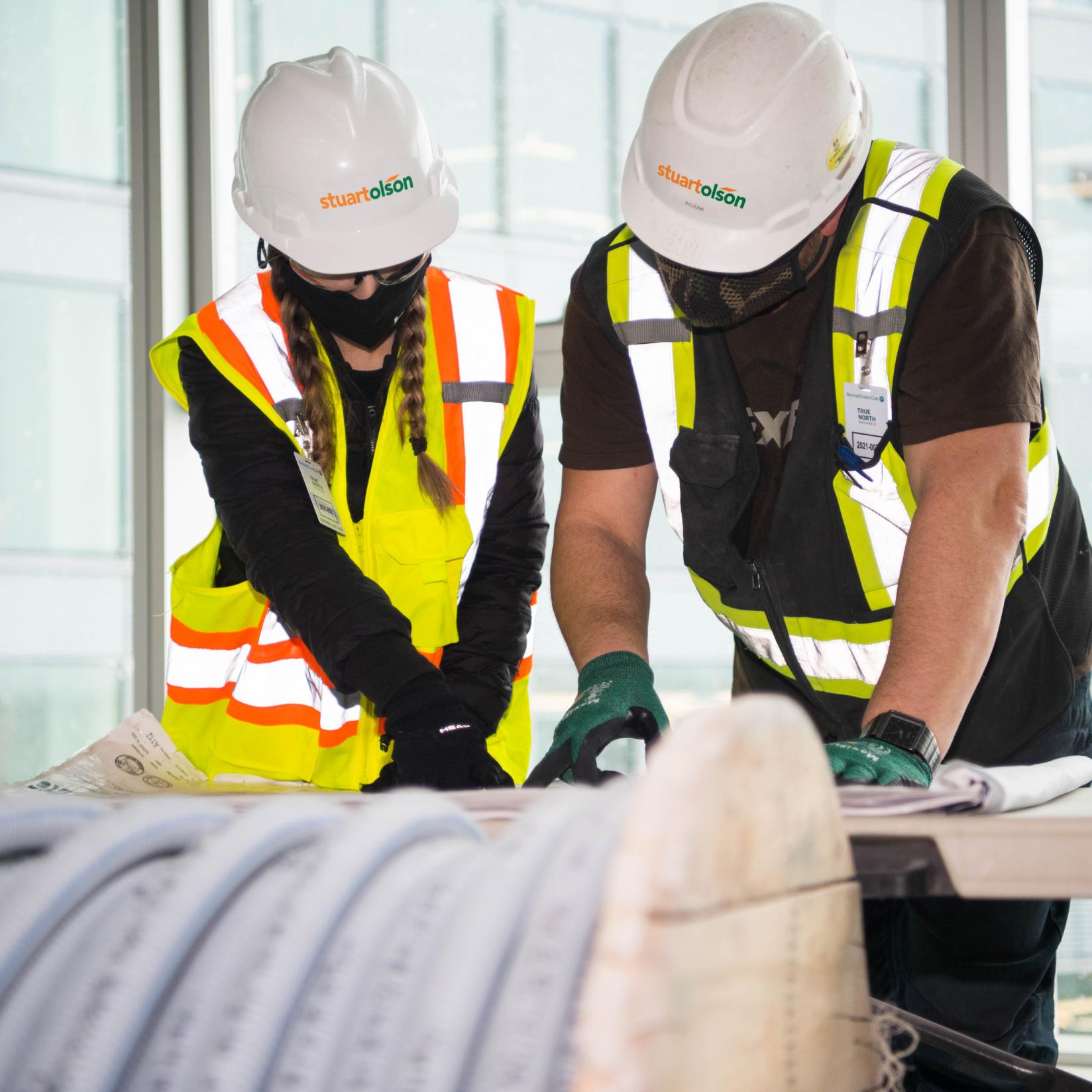When Ciara Glen first started her role as manager of organizational design at Bird Construction, she noticed that her co-workers often introduced themselves as legacy employees of either Bird or Stuart Olson.
“People were really proud of where they came from – the organization and its culture,” Ciara recalls. “They clearly cared about each other. But as a new employee, I wondered where I fit in. I didn’t have a legacy organization to identify with.”
Bird Construction is a leading Canadian construction company operating from coast-to-coast and servicing all of Canada’s major markets. For over 100 years, they’ve been a people-focused company with an unwavering commitment to safety and a high level of service. In 2020, Bird joined forces with Stuart Olson, an historic Canadian builder in its own right, to broaden their scope and service offering.
Bird President and CEO Teri McKibbon and Chief People Officer Brian Henry recognized early on that they’d need to integrate the company’s cultures in order for the merger to be successful. They acknowledged that the two companies shared strong values around safety, integrity and a drive for excellence, but there was also a need to develop a through-line that would allow them to move forward as One Bird while keeping the best parts of each legacy organization.
“Bird and Stuart Olson were similar in size,” explains Brian. “When we merged, we didn’t want to impose one company’s way on the other. It made sense to step back and carve out a unified culture, so we could move together as One Bird. This was a chance for us to pause and think more long-term about who we wanted to be.”
Finding the right partner
When it came time to choose a partner for this journey, the Bird team wanted to work with an experienced team who were proven experts in the space of culture and employee experience.
“I had seen Habanero on stage, winning awards at Great Place to Work events for about seven or eight years,” says Brian. “I knew we wanted to work with them at some point. The sophistication, capability and competency of Habanero is aligned with Bird now and where we want to go.”
The appreciation was mutual. As Habanero Experience Designer Toni Albert recalls, “I was excited to work on culture and employee experience in the contracting and construction industry. Teri and Brian both had a strong vision for how this was going to come together, why it was important, and the significance of employee collaboration.”
Designing the approach
Culture is the sum of everyone’s experiences and perceptions in an organization. It is deeply personal and can be hard to articulate. The experience of Bird’s culture integration project – how it would affect employees, open their minds and create growth – required careful planning of all the touchpoints and interactions. The overall experience was designed to be engaging, psychologically safe and focused on what matters most.
Understanding employees’ experiences with culture
Hearing employees describe their experiences in their words is powerful. Personal stories lend legitimacy to the data and help others truly understand what employees are experiencing.
The Hab team spoke to 163 people – about 11% of their salaried and full-time hourly employee base – in 23 workshops. When planning the workshops, they took great care in finding the right balance of people to ensure all areas of the business were represented. The sessions acted as discovery sessions, helping shine a light on the beliefs, attitudes and behaviours underpinning Bird’s merged organization.
To unearth these themes, Senior Advisor, Workplace Experiences, Caterina Sanders, Experience Designer Laura Nugent and Toni facilitated conversations that went beyond asking people what they want – they explored employees’ lived experiences, uncovering insights about their journey, and seeking meaning, patterns and actions from them. The process helped Bird employees connect more to the organization and each other and to know that their opinions and experiences matter.
“Caterina, Toni and Laura showed a lot of compassion and respect for everyone,” says Ciara. “They made the workshops a place for employees to openly share and contribute. I know that's something people really appreciated.”
“We’ve heard that these sessions can feel a bit like therapy,” says Toni. “It can get emotional, especially if we're working with teams who are processing change and uncertainty. This is a safe space with a neutral party where people can share their honest feelings.”
The conversations that emerged during the sessions revealed employees’ beliefs and expectations of Bird, the impact the merger had on their work and to what extent these experiences were shared across the organization – or not.
“We wanted to know if everyone was having a common experience,” says Toni. “It turns out they weren’t. Some regions were untouched by the merger, while others felt the impacts in their day-to-day roles.”
Gauging workplace mindsets
To balance the deep insights gained from the workshops, over 2,200 employees were invited to participate in a workplace mindset survey that provided a picture of people’s motivations and goals.
Developed by Habanero with the University of British Columbia and El Colegio de México, the workplace mindset survey is based on research into the workplace motivations that lead to high performance in individuals, teams and organizations.
The anonymous survey results gave the Hab team a baseline understanding of how team-oriented Bird employees were, as well as how they perceived the team-orientation of their peers and leadership. It also revealed what cultural integration already existed, and where.
The results showed that Bird employees were very strongly oriented to teamwork and collaboration. This held equally true in how they saw themselves, how they viewed their peers and how they felt about their leaders. These findings mirrored what the team heard in the workshops.
“The mindset survey asked some probing questions,” explains Toni. “People were taken aback by questions about their allegiance to the team. They feel a deep sense of dedication to each other at Bird, so even the thought of an employee putting themselves ahead of others was offensive to them. It reaffirmed and validated what we were seeing in workshops – that people care deeply about their coworkers and leaders.”
Synthesizing and analyzing the data
The Hab team combined their insights from the mindset survey and interviews with workshop findings to create a holistic picture of the current state of Bird’s culture. They then worked collaboratively with Ciara and the project team to identify themes and opportunities.
What emerged was a clear set of themes that showed strong alignment in values across both legacy organizations. In fact, one of the key findings was that the companies’ cultures were actually quite similar.
When they dug deeper, the findings also showed areas where employees were struggling with the merger.
“The findings exposed gaps in communication due to organizational siloes, and some employee fears that hadn't yet been articulated to everybody at the company,” explains Toni. “They were concerned that what they know and love about their work was going to be taken away from them.”
Sharing the findings was an opportunity for everyone to hear the employees’ concerns and know that they aren’t coming from an isolated group of people – everyone was feeling that way.
The project’s research findings are also providing sustained benefits. This rich data now helps inform the best ways to communicate with Bird employees and stakeholders.
Building a journey plan
The research also revealed opportunities, which the team used to develop a journey plan made up of a backlog of initiatives designed to enable cultural integration and support employee experience.
Bird’s journey plan is much more than a detailed task list; it’s a dynamic mechanism for expressing their current and future priorities for cultural integration. It also includes details like ownership and impact measurement to ensure transparency and accountability.
As Toni explains, “A backlog is more agile than a roadmap. With Bird’s journey plan, they can move things around and shift priorities in response to the needs of employees and the business.”
The journey plan allows for and even encourages them to experiment in the opportunity areas they’ve identified. By focusing on learning, measurement, and organizational listening, they’ll ensure Bird’s culture is continuously evolving in a positive, unified direction.
“Habanero encouraged us to see the journey plan as a living document,” says Ciara. “Things should happen organically when people are ready. That’s been truly a positive thing. It won’t be hard for us to implement any of these initiatives because everyone's asking for them already. Employees are ready for the change.”
Bringing the program to life is a combination of identifying, rallying and recruiting accountability for the elements of the backlog. Culture is shared across an organization, so Bird’s journey plan draws in and relies on employees from diverse roles and functions to make it succeed.
Putting it into action
Some of the first initiatives on Bird’s journey plan were a revised purpose statement, a set of values and an employee value proposition. These were identified early on as high-priority, high-impact items that could help align employees around One Bird culture.
Developing these artefacts was a natural next step from the research findings. The Hab team worked collaboratively with Bird to co-create the statements, which capture the themes that resonated strongly with their employees in language that reflects their experience.
“These statements have given people a language to articulate the way we work with each other and how we show up for each other,” says Ciara. “It's been exciting to see how people are inspired and motivated by them. Habanero pushed us to keep the language in the statements aligned with what they heard in the workshops, so they sound down-to-earth and authentic, which has made it so easy for employees to understand and connect with them.”
The power of cultural alignment
Bird is seeing results already. Employees are more aligned around the idea of a One Bird culture – they are clear on what it means and the role they can play in bringing it to life.
“I see great collaboration across businesses and teams,” says Brian. “I see support for the people and clients we work for. We haven’t lost our key ingredients. Instead, we’ve heightened them.”
Bird recently formalized their recognition system and launched an excellence award program for employees who show outstanding safety, collaboration, resiliency, community, and performance. Since their cultural integration journey, they’ve received a record number of nominees.
“If we’d done it before, we wouldn’t have received as many submissions,” says Brian. “And people were nominating employees from other teams and divisions.”
The company also revamped its performance management system to align with their One Bird values. Instead of annual reviews, leaders now have ongoing conversations with employees about their career development. Leaders are encouraged to choose a value to focus on, then engage in activities and conversations with employees to bring that value to life together over the course of the year. The results are clear, with more employees engaging than ever before.
“Our old performance management system had 15 to 20 percent compliance at most. After we revised the process to align with our values, we’re seeing at least 75 percent compliance for career check-ins. That’s only going to make us stronger,” says Brian.
Moving forward as One Bird
Cultural integration has changed Bird's strategic decision-making capabilities, too.
“Now that we’re more unified, we’re continuing to pursue even more business that’s strategically aligned,” says Brian. “We assess business by its contribution to the profit share of the whole company instead of by its benefit to each individual business. Our targets are now driven by the One Bird strategy.”
For Ciara and other new employees at Bird, cultural integration means there’s no longer any question where they belong. “We have different histories, and we all bring something unique to the table,” she says. “But as One Bird, we are moving forward towards a shared goal with a common language. It’s empowered us to be more consistent in our employee and client experiences, and people have really embraced it.”









.jpeg?bc=white&la=en&mw=416&modified=20251202191043&hash=E64AA9DFFAE8D1AC27890831F714D5B0FA2FEBB2)

